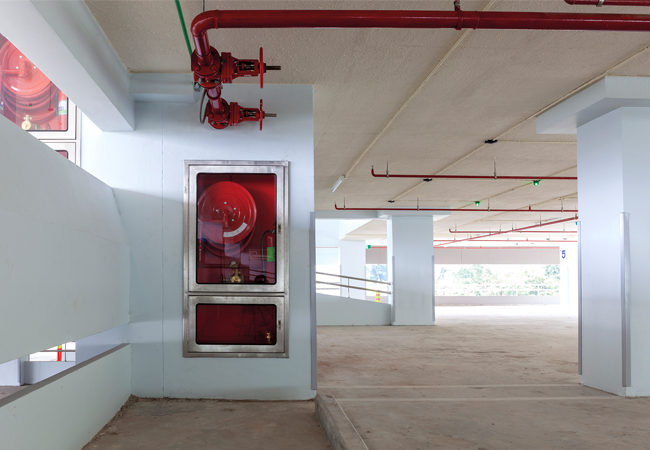
Credit: iStock.com – AJ_Watt
The Higher-Risk Buildings (Management of Safety Risks etc) (England) Regulations 2023 implement many of the provisions for the operational management of higher risk buildings (HRBs) that are enabled by Part 4 of the Building Safety Act 2022. They include detailed provisions for reporting on the safety of the building, the new “safety case report”.
Accountable Persons will have to lodge information about the HRB when applying for a building assessment certificate and keep that information accurate and up to date. There is a duty on the regulator to be satisfied that when the Certificate is granted all relevant requirements relating to the building and its management are being met.
Duties are imposed on APs to inform any other AP for any part of the building in the event that a Certificate is refused, or conditions imposed which require improvements within a certain period.
Regulation 4 of the HRB Management Regulations sets out the prescribed principles created by section 84 of the Building Safety Act. These set into regulation the hierarchy of risk mitigation by avoiding, reducing, or controlling risks in the building. They also require a regular inspection, testing, and maintenance regime and give precedence to collective protective measures over individual ones.
There is also a principle that the AP must consider the impacts of risks on residents and engage with them. Talking to the tenants or leaseholders will no longer be an optional extra, it becomes a duty.
Finally, there is a duty on the AP to ensure (and that is the word used and the standard set) that any person “responsible for or assisting with compliance with a duty in or under Part 4 of the 2022 Act has the relevant competence”.
Regulation 5 sets out the requirements for safety case reports for an HRB and the information that they must contain. This covers details of the systems for managing works and evacuation of the building when required. The safety case report must be “kept in electronic form” and any changes must be notified to the regulator with an explanation of the reason for the change.
There is also a principle that the AP must consider the impacts of risks on residents and engage with them. Talking to the tenants or leaseholders will no longer be an optional extra, it becomes a duty.
The article on the new HRB Procedures explains the mandatory occurrence reporting requirements that are introduced during the construction of an HRB, and Regulation 6 of the HRB Management regulations pick up on this theme, with a similar duty in relation to a relevant safety occurrence in the building which could cause a serious risk of a significant number of deaths or injuries.
Regulations 7 – 9 cover the keeping of information about the HRB and providing that information to the Regulator and to other APs in the building, including changes in AP. They also set out the requirement on the AP to provide information to residents on the occupation of the HRB, to all those currently resident in an existing HRB, and on changes of occupancy in flats or apartments.
Regulation 10 sets out the requirements to implement a resident’s engagement strategy as prescribed in Section 91 of the Building Safety Act. Once prepared the strategy must be reviewed at least every two years or sooner if a mandatory occurrence has been reported or material building work undertaken. The regulation also sets out what is required in the engagement strategy.
This includes how the AP will inform residents about any building safety works that will be carried out, and why they are being carried out, including the timing and arrangement of such safety work (unless an emergency).
The AP must also consult residents and take account of their responses, keeping a record of reviews of the strategy and setting out in writing how residents will be consulted on reviews of the strategy or on building safety decisions. Regulation 11 requires the AP to provide information with ‘plain English summaries of complex or technical provisions’.
Regulation 12 sets out the requirement for the AP to put in place a formal complaints system that offers a fair and impartial process for dealing with any relevant complaints about
Once again, this is all well signposted in previous consultations with the sector and in the Building Safety Act itself. There is nothing here that changes the technical standards that apply to HRBs. What it does do is spell out what good management practice in an HRB looks like.
[QUOTEBLOCK]For those that are tempted to argue that this is all happening a bit fast, it’s worth asking what it is that they aren’t already doing? Not employing competent people? Not considering the residents?[/QUOTEBLOCK]
For those that are tempted to argue that this is all happening a bit fast, it’s worth asking what it is that they aren’t already doing? Not employing competent people? Not considering the residents? Not having a proportionate risk identification and management system based on well-established principles? It will be a brave AP who comes out and admits to any of those failings.
Bodies such as CIBSE will be working together with the Construction Leadership Council and Its constituent bodies to provide further industry guidance on these regulations and on how clients, principal designers and contractors, and Accountable Persons can meet the new obligations in a safe, reasonable and proportionate manner. It is another step on the road to rebuilding trust in the construction and operation of our higher-rise building stock, and another step on the road to building a safer future.
- CIBSE will be setting out the breadth of regulatory changes and new requirements of the building regulations at the one day conference: Building Safety: Meeting the Building regulations and delivering the Golden Thread on 28 September, London. For more information and to book visit CIBSE Golden Thread series.
ABOUT THE AUTHOR
Dr Hywel Davies is a former chair of the Building Regulations Advisory Committee who has worked in the field of regulations and standards for over 35 years. He is chief technical officer of the Chartered Institution of Building Services Engineers and an Honorary Fellow of CIBSE.
Links to new regulations
The new regulations deliver the recommendations of Dame Judith Hackitt in her report Building A Safer Future and cover the technical detail underpinning the new, more stringent regime for the design and construction of higher-risk buildings, wider changes to the Building Regulations for all buildings and the details of the new in-occupation safety regime for higher-risk buildings.
Amendments announced on August 17 2023:
The Building Regulations etc. (Amendment) (England) Regulations 2023
The Building Regulations (Higher-Risk Building Procedures) (England) 2023
The Building (Approved Inspectors etc. And Review of Decisions) (England) Regulations 2023
The Higher-Risk Buildings (Management of Safety Risks etc) (England) Regulations 2023
The Building Safety Act 2022 (Consequential Amendments etc.) Regulations 2023
A summary of all secondary legislation can be found at:
The Building Safety Act: secondary legislation






